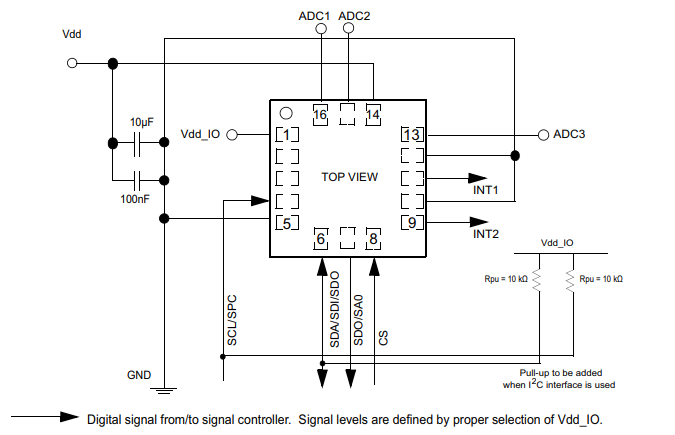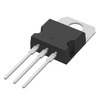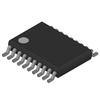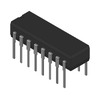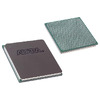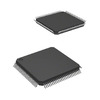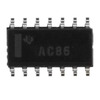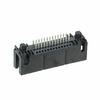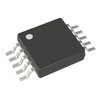Exploring the LIS3DH Accelerometer: Datasheet, Pinout, Functionality, and Block Diagram
The LIS3DH is a high-performance, ultra-low-power three-axis accelerometer designed for various applications, including consumer electronics, industrial automation, and healthcare. Its I2C/SPI digital interface and compact design offer precise acceleration measurement in three dimensions, making it ideal for motion detection and orientation sensing. This versatile sensor stands out for its power efficiency, embedded self-test features, and temperature sensor, ensuring reliable performance even in challenging environments. Whether in smartphones, wearable devices, or health monitoring systems, the LIS3DH enhances functionality and energy management, making it a key component in modern, energy-efficient designs.
Catalog
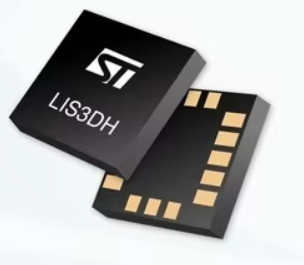
LIS3DH Overview
The LIS3DH stands out due to its deficient power consumption and sophisticated energy-saving features. This makes it an ideal choice for applications needing top-tier performance with minimal energy expenditure. It offers configurable full-scale ranges of ±2g, ±4g, ±8g, and ±16g, with output data rates from 1 Hz to 5.3 kHz, providing substantial versatility across different uses. Specifically, the self-test capabilities ensure system functionality, reinforcing reliability.
A notable characteristic of the LIS3DH is its ability to generate interrupts based on device positioning or inertial events, with defined thresholds and timing settings. This functionality allows applications to swiftly adapt to environmental changes, improving responsiveness. For example, healthcare gadgets might leverage these features for fall detection or movement monitoring, ensuring patient safety and accurate data collection. The programmability and sensitivity of the interrupt generation elevate the utility of the LIS3DH in such scenarios.
The integrated 32-level FIFO buffer minimizes the necessity for constant host processor activity, significantly conserving system resources. This is mostly beneficial when power efficiency is a priority, such as in wearable devices where extended battery life is a competitive advantage. By efficiently managing data storage and transfer, the LIS3DH optimizes overall system operations, prolonging the product's usable life without compromising performance. The LIS3DH’s compact LGA package design ensures effortless incorporation into a variety of devices while supporting stable operation across a temperature range of -40°C to +85°C. This durability makes it suitable for both consumer electronics and industrial applications, where extreme environmental conditions might prevail. For instance, in automotive systems, the capability to perform reliably under fluctuating temperatures is useful for maintaining performance consistency and upholding safety standards.
LIS3DH Pin Configuration

|
Pin# |
Name |
Function |
|
1 |
Vdd_IO |
Power
supply for I/O pins |
|
2 |
NC |
Not
connected |
|
3 |
NC |
Not
connected |
|
4 |
SCL |
I²C
serial clock (SCL) |
|
SPC |
SPI
serial port clock (SPC) |
|
|
5 |
GND |
0 V
supply |
|
6 |
SDA |
I²C
serial data (SDA) |
|
SDI |
SPI
serial data input (SDI) |
|
|
SDO |
3-wire
interface serial data output (SDO) |
|
| 7 |
SDO |
SPI
serial data output (SDO) |
|
SA0 |
I²C
less significant bit of the device address (SA0) |
|
|
8 |
CS |
SPI
enable |
|
I²C/SPI
mode selection: |
||
|
1:
SPI idle mode / I²C communication enabled |
||
|
0:
SPI communication mode / I²C disabled |
||
|
9 |
INT2 |
Inertial
interrupt 2 |
|
10 |
RES |
Connect
to GND |
|
11 |
INT1 |
Inertial
interrupt 1 |
|
12 |
GND |
0 V
supply |
|
13 |
ADC3 |
Analog-to-digital
converter input 3 |
|
14 |
Vdd |
Power
supply |
|
15 |
ADC2 |
Analog-to-digital
converter input 2 |
|
16 |
ADC1 |
Analog-to-digital
converter input 1 |
LIS3DH CAD Details
Electrical Symbol
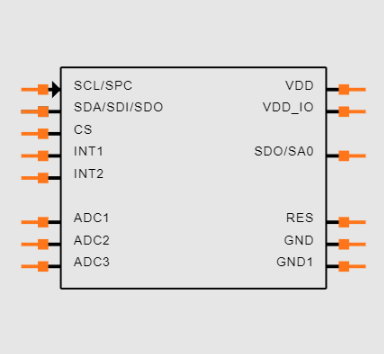
PCB Footprint
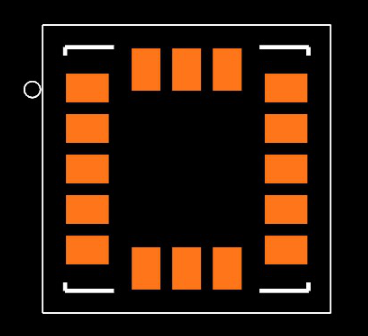
3D Model

Key Features of LIS3DH
|
Feature |
Description |
|
Wide Supply Voltage |
1.71 V to 3.6 V |
|
Independent IO Supply |
1.8 V, supply voltage compatible |
|
Ultra-low Power Mode Consumption |
Down to 2 μA |
|
Dynamically Selectable Full Scale |
±2g/±4g/±8g/±16g |
|
Digital Output Interface |
I2C/SPI |
|
Data Output Resolution |
16-bit |
|
Programmable Interrupt Generators |
2 independent generators for free-fall and motion
detection |
|
Orientation Detection |
6D/4D detection capability |
|
Free-fall Detection |
Supported |
|
Motion Detection |
Supported |
|
Embedded Temperature Sensor |
Integrated |
|
Embedded Self-Test |
Integrated |
|
Embedded FIFO |
32 levels of 16-bit data output FIFO |
|
High Shock Survivability |
10000 g |
|
Environmental Compliance |
ECOPACK®, RoHS, and "Green" compliant |
Functional Capabilities of LIS3DH
The LIS3DH accelerometer features a diverse array of functionalities that make it highly versatile for various applications, especially in the world of mobile and portable devices. Its orientation detection feature is major for conserving energy and efficiently managing automated image positioning. This capability goes beyond simple screen rotation, and fine-tuning device behavior to minimize unnecessary power usage.
Orientation Detection and Energy Conservation
One of the most impressive features of the LIS3DH is its orientation detection. This function is invaluable not only for adjusting screen orientations but also for triggering different operational modes based on the device’s orientation. For instance, when a tablet is laid flat, the accelerometer can prompt the device to enter a low-power state, resulting in prolonged battery life.
Advanced Mode Capabilities
The LIS3DH offers both 4D and 6D modes. The 4D mode is designed to ignore the Z-axis during position detection, functioning effectively in scenarios where XY-plane orientation suffices. This mode can intelligently transition to low-power mode upon detecting certain predefined events (customizable by the through threshold and duration parameters).
Adaptive Power Management
The LIS3DH transitions to a low-power state when specific conditions are detected, and it returns to its normal or high-resolution operational mode seamlessly once these conditions are resolved. This is mainly useful in wearable devices, where balancing performance and power efficiency is dominant. For example, fitness trackers can deactivate high-resolution tracking during periods of inactivity, greatly extending battery life.
Efficient Data Handling
The LIS3DH supports a 32-level FIFO buffer, enabling various operational modes such as FIFO, Stream, Stream-to-FIFO, and FIFO Bypass. This advanced buffering ensures efficient data handling, significantly easing the processing load on the main processor. This leads to smoother and faster data processing, a basic aspect of applications like motion sensing in gaming controllers.
Technical Specifications
|
Type |
Parameter |
|
Lifecycle
Status |
PREVIEW
(Last Updated: 8 months ago) |
|
Mounting
Type |
Surface
Mount |
|
Package
/ Case |
16-VFLGA |
|
Surface
Mount |
Yes |
|
Number
of Pins |
16 |
|
Packaging |
Tray |
|
JESD-609
Code |
e4 |
|
Part
Status |
Obsolete |
|
Moisture
Sensitivity Level (MSL) |
3
(168 Hours) |
|
Number
of Terminations |
16 |
|
ECCN
Code |
EAR99 |
|
Type |
Digital |
|
Terminal
Finish |
Nickel/Gold
(NI/AU) - Electrolytic |
|
HTS
Code |
8542.39.00.01 |
|
Voltage
- Supply |
1.71V
~ 3.6V |
|
Terminal
Position |
Bottom |
|
Terminal
Form |
Butt |
|
Peak
Reflow Temperature (°C) |
260°C |
|
Number
of Functions |
1 |
|
Supply
Voltage |
2.5V |
|
Terminal
Pitch |
0.5mm |
|
Dimensions
(L x W x H) |
3mm
x 3mm x 1mm |
|
Time
@ Peak Reflow Temp (Max) |
30
seconds |
|
Base
Part Number |
LIS3 |
|
Pin
Count |
16 |
|
Output
Type |
I2C,
SPI |
|
Operating
Supply Voltage |
2.5V |
|
Interface |
I2C,
SPI |
|
Operating
Supply Current |
11μA |
|
Resolution |
2 B |
|
Sensor
Type |
3-Axis |
|
Max
Supply Voltage (DC) |
3.6V |
|
Min
Supply Voltage (DC) |
1.71V |
|
Axis |
X,
Y, Z |
|
Acceleration
Range |
±2g,
4g, 8g, 16g |
|
Features |
Adjustable
Bandwidth, Selectable Scale, Temperature Sensor |
|
Sensitivity
(LSB/g) |
1000
(±2g) ~ 83 (±16g) |
|
Radiation
Hardening |
No |
|
REACH
SVHC |
No
SVHC |
|
RoHS
Status |
ROHS3
Compliant |
|
Lead
Free |
Yes |
Block Diagram of LIS3DH
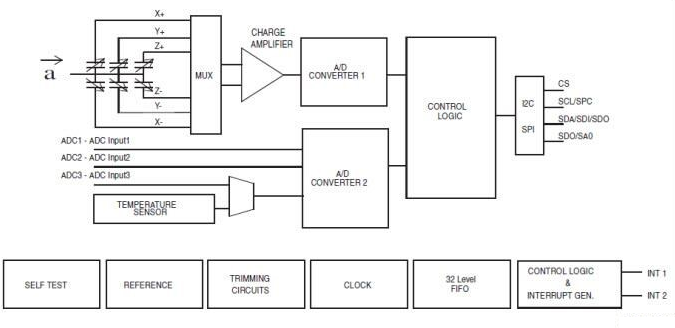
Alternatives to LIS3DH
|
Part
Number |
Description |
Manufacturer |
|
LIS3DE |
MEMS digital
output motion sensor ultra low-power high performance 3-axes "nano"
accelerometer |
STMicroelectronics |
|
LIS3DETR |
Digital 3-axis
accelerometer, ultra-low-power, ±2g/4g/8g/16g full scale, high-speed I2C/SPI
digital output, embedded FIFO, LLGA 16 3x3x1.0 package |
STMicroelectronics |
|
LIS3DHTR |
3-axis MEMS
accelerometer, ultra-low-power, ±2g/4g/8g/16g full scale, high-speed I2C/SPI
digital output, embedded FIFO, high-performance acceleration sensor, LLGA 16
3x3x1.0 package |
STMicroelectronics |
Implementing LIS3DH
Core and I/O Requirements
For the LIS3DH to function properly, its core requires a Vdd line, and the I/O pads need Vdd_IO. Power supply decoupling capacitors, including a 100 nF ceramic and a 10 μF aluminum capacitor, must be located close to pin 14. Placing these capacitors strategically reduces noise and enhances stability. All voltage and ground supplies should be present simultaneously to ensure proper initialization and functionality of the device. Notably, Vdd can be removed while maintaining Vdd_IO to keep the communication bus active. This setup allows certain communication tasks to continue, although measurement capabilities will be disabled. In this state, the sensor effectively enters a low-power mode.
Interface Options and Flexibility
The LIS3DH supports both I2C and SPI interfaces. These interfaces provide flexibility based on system design and data throughput requirements, facilitating seamless data transfer and integration into various applications.
Programmable Interrupt Functions
The programmable interrupt functions include configurable thresholds and timing. This adaptability allows for custom-tailored operations, proving advantageous in applications like motion detection and gesture recognition, where precise and responsive interrupt mechanisms are desirable.
Handling Unused ADC Pins
The unused ADC1, ADC2, and ADC3 pins can be left floating or tied to Vdd or GND. This practice ensures there is no unnecessary power consumption or potential floating pin issues, maintaining system integrity.
Practical Applications of LIS3DH
Motion-Triggered Functions
The LIS3DH plays a major role in applications demanding precise motion detection. Its utility lies in activating devices or features upon detecting specific movements, such as launching a fitness application when you start running. The accelerometer's sensitivity ensures reliable performance within challenging environments. Its practicality is evident across various consumer electronics. It enables a seamless experience, reducing the reliance on manual operation.
Free-Fall Detection
A standout feature of the LIS3DH is its proficiency in detecting free-falls. This capability serves to protect delicate electronics from potential damage. For example, laptops and smartphones can automatically initiate protective measures upon sensing a fall, thereby mitigating impact forces. This technology safeguards personal gadgets and extends to industrial applications, securing costly and sensitive equipment.
Click/Double-Click Recognition
The LIS3DH enhances your device interactions with its ability to recognize click and double-click gestures. This functionality is mainly beneficial for wearable technology, where physical buttons are less practical. Smartwatches, for instance, employ accelerometer-based click recognition for more intuitive control, eliminating the need for additional hardware. This integration leads to more sophisticated and friendly interfaces.
Smart Power Management
Efficient power management is a significant application of the LIS3DH. By detecting whether a device is in use or stationary, the accelerometer plays a major role in extending battery life. This feature is immensely valuable in portable electronic devices that depend on prolonged battery performance. Implementing optimized power management techniques meets the demands of increasingly compact and powerful devices.
Pedometers
In the world of health and fitness technology, the LIS3DH is a core component for precise tracking of steps and movements. It is requisite in pedometers, providing you with reliable data to monitor physical activities. The accelerometer's capability to distinguish various types of motion ensures consistent and valuable fitness tracking data.
Display Orientation Adjustments
The LIS3DH is instrumental in managing display orientation by detecting device position and movement. This ability allows automatic screen adjustments for optimal viewing. Common in smartphones and tablets, this feature significantly enhances your experience while also supporting accessibility by adapting seamlessly to your needs.
Gaming and VR Inputs
The LIS3DH is requisite in gaming and virtual reality, providing accurate motion-based inputs. It enables immersive and intuitive gaming experiences by detecting tilt, rotation, and acceleration precisely. This technology bridges the gap between physical movement and digital response, enhancing player engagement and practicality in virtual environments.
Impact Detection
In various safety and security applications, the LIS3DH excels in impact detection. For instance, in the automotive industry, it can trigger airbags or other safety mechanisms upon sensing a collision. This application is a testament to the necessity for reliable and swift responses in critical situations, ultimately saving lives and reducing injury severity.
Vibration Monitoring
Vibration monitoring is another major application of the LIS3DH. It is active in maintaining machinery and structural health by detecting anomalous vibrations indicative of potential failures. This proactive approach proves beneficial across multiple industries, facilitating timely maintenance and reducing operational downtime. The LIS3DH ensures continuous operation and helps prevent costly breakdowns.
Package Information for LIS3DH
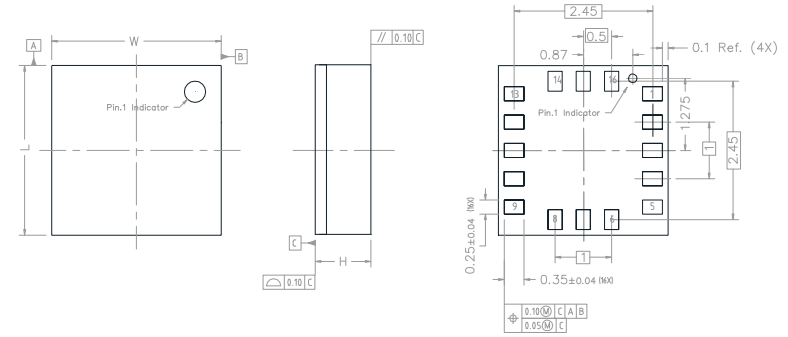
About STMicroelectronics
STMicroelectronics thrives as a premier global semiconductor company, excelling in the innovation, development, and distribution of advanced microelectronics solutions. Their leadership emanates from profound expertise in silicon technologies, rigorous manufacturing practices, extensive intellectual property portfolios, and strategic alliances. These facets strategically position STMicroelectronics at the forefront of advanced System-on-Chip (SoC) technologies, significantly driving the convergence trends in contemporary applications.
STMicroelectronics' journey spans decades, evolving from a traditional semiconductor manufacturer to a cutting-edge innovator in microelectronics. Their transformation emphasizes the industry’s shift towards more integrated solutions. Adaptability and foresight have cemented their pioneering position, with lessons from market demands and technological advancements shaping their path.
STMicroelectronics has refined its mastery of silicon technologies, forming the backbone of its innovation. Silicon semiconductors play a dominant role in crafting efficient and compact microelectronics solutions. Their technical prowess and market acumen are evident in their relentless pursuit of technological feasibility. This depth of knowledge continually propels them beyond current market standards.
Datasheet PDF
LIS3DH Datasheets:
LIS3DETR Datasheets:
LIS3DHTR Datasheets:
Frequently Asked Questions [FAQ]
1. What is LIS3DH?
The LIS3DH is an ultra-low-power, high-performance three-axis linear accelerometer featuring a digital I2C/SPI interface. It’s crafted for precise motion detection and measurement in various applications, ranging from consumer electronics to industrial systems. This device stands out for its efficiency and adaptability, making it a favorite in many precise monitoring scenarios.
2. What is a 3-axis accelerometer?
A 3-axis accelerometer measures acceleration along three perpendicular axes (X, Y, and Z). This multidirectional capability allows for comprehensive motion sensing. It's useful in fields such as robotics, aerospace, and wearable technology. Tracking movement across all dimensions brings a depth of analysis that transforms simple data into actionable insights.
3. Can an accelerometer measure speed?
While accelerometers inherently measure acceleration, speed can be derived by integrating acceleration data over time. The practical application, however, necessitates careful calibration. This process must account for factors like sensor noise and drift to ensure accurate speed estimation. In contexts such as vehicular telemetry and gait analysis, this transition from raw data to meaningful speed metrics demands meticulous attention, reflecting the precision required in these fields.
4. How accurate is an accelerometer?
The accuracy of an accelerometer can vary significantly, influenced by its specifications and the context in which it’s used. High-accuracy accelerometers, such as those in medical devices or precise pedometers, can achieve measurement accuracy within ±1% for walking distance. This level of precision is often the outcome of rigorous testing and calibration processes, ensuring dependable performance in sensitive applications where every fraction matters.
About us
ALLELCO LIMITED
Read more
Quick inquiry
Please send an inquiry, we will respond immediately.

LM311N Voltage Comparator: Features, Pinout, and Datasheet
on October 17th
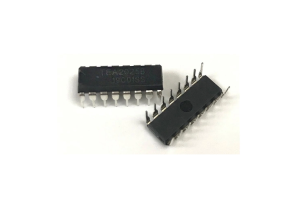
Understanding TEA2025 Circuit Diagrams and Applications
on October 16th
Popular Posts
-

What is GND in the circuit?
on January 1th 3272
-

RJ-45 Connector Guide: RJ-45 Connector Color Codes, Wiring Schemes, R-J45 Applications, RJ-45 Datasheets
on January 1th 2815
-

Understanding Power Supply Voltages in Electronics VCC, VDD, VEE, VSS, and GND
on November 20th 2637
-

Fiber Connector Types: SC Vs LC And LC Vs MTP
on January 1th 2265
-

Comparison Between DB9 and RS232
on January 1th 1882
-

What Is An LR44 Battery?
Electricity, that ubiquitous force, quietly permeates every aspect of our daily lives, from trivial gadgets to life-threatening medical equipment, it plays a silent role. However, truly grasping this energy, especially how to store and efficiently output it, is no easy task. It is against this background that this article will focus on a type of coin cell battery that may seem insignificant on the...on January 1th 1846
-

Understanding the Fundamentals:Inductance Resistance, andCapacitance
In the intricate dance of electrical engineering, a trio of fundamental elements takes center stage: inductance, resistance, and capacitance. Each bears unique traits that dictate the dynamic rhythms of electronic circuits. Here, we embark on a journey to decipher the complexities of these components, to uncover their distinct roles and practical uses within the vast electrical orchestra. Inductan...on January 1th 1807
-

What Is RF and Why Do We Use It?
Radio Frequency (RF) technology is a key part of modern wireless communication, enabling data transmission over long distances without physical connections. This article delves into the basics of RF, explaining how electromagnetic radiation (EMR) makes RF communication possible. We will explore the principles of EMR, the creation and control of RF signals, and their wide-ranging uses. The article ...on January 1th 1800
-

CR2430 Battery Comprehensive Guide: Specifications, Applications and Comparison to CR2032 Batteries
What is CR2430 battery ?Benefits of CR2430 BatteriesNormCR2430 Battery ApplicationsCR2430 EquivalentCR2430 VS CR2032Battery CR2430 SizeWhat to look for when buying the CR2430 and equivalentsData Sheet PDFFrequently Asked Questions Batteries are the heart of small electronic devices. Among the many types available, coin cells play a crucial role, commonly found in calculators, remote controls, and ...on January 1th 1799
-

Comprehensive guide to hFE in transistors
Transistors are crucial components in modern electronic devices, enabling signal amplification and control. This article delves into the knowledge surrounding hFE, including how to select a transistor's hFE value, how to find hFE, and the gain of different types of transistors. Through our exploration of hFE, we gain a deeper understanding of how transistors work and their role in electronic circu...on November 20th 1782
